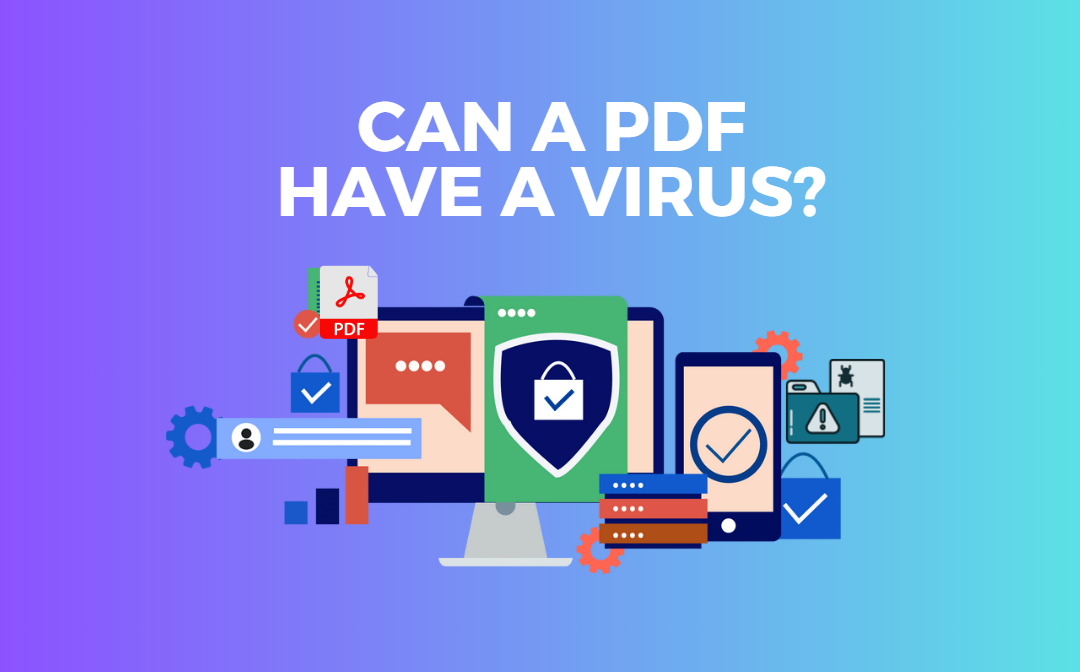You can probably get away from so much with your PDFs, but being careless is not one of them. Like other file types on your device, PDFs are easily targeted by actors and can be infected by viruses and other threats.
Due to their popularity and universality, hackers always find ways to use PDFs as conduits for security threats via malicious code. This makes them susceptible to viruses and other harmful security threats like Malware and Trojans.
This blog will cover everything you should know about PDF files and how to ensure the security of your files online.

Read on to learn more!
Understanding How PDFs Work
PDFs are a widely used and convenient file format for document sharing. As its name suggests, a PDF file is a Portable Document Format that preserves documents' original appearance and formatting, regardless of the device or platform in use.
It’s a file format you can easily rely on to distribute documents or share contracts and enjoy various benefits over using software like Microsoft Word. For example, a PDF is a platform-independent file format—something you won’t get with other file formats.
You can view any document shared in PDF and even print it on various operating systems without requiring the original software used to create it. PDF files are also small and convenient for storage. You can safely store them without the risk of depleting your device storage.
However, PDF's convenience and popularity are both a blessing and curse. They’re among the most targeted file types for viruses and malware attacks.
Attackers understand PDFs are essential to our day to day lives and have designed discreet ways to hide viruses, Malware, and Trojans in PDFs. This will often manifest when you download the file or share it as an attachment.
PDFs and Viruses: How Virus Attacks Are Orchestrated
PDFs are secure file types, often locked down to avoid editing. Some files have dynamic fields for forms or embedded signatures. So, why would such a secure file be susceptible to virus attacks?
Well, attackers usually take advantage of vulnerabilities in these features and exploit them with virus attacks. They'll exploit the elements within the file format via techniques such as embedding malicious JavaScript, creating deceiving hyperlinks, or hiding harmful attachments.
Below is a look into some of the potential security risks associated with PDF files.
-
Malicious Links and URLs
Criminals will identify a PDF file and embed links and URLs within it. The links and URLs are usually a deception that leads you to a dangerous website. Some links are fashioned, so you'll initiate malicious content downloads once you open them.
Criminals will try to circumvent safety protections on your device by embedding or encrypting other objects within the PDF to prevent detection. The file will appear initially safe, but the hidden objects are executed once you open it.
-
JavaScript Attack
JavaScript, a programming language supporting web functionality, is also used for PDF attacks. Attackers know PDFs use JavaScript to add dynamic details like fillable forms, making them vulnerable. The PDFs can contain concealed JavaScript code that exploits vulnerabilities.
Malicious PDFs might use this code to execute harmful scripts. You'll initiate an attack if you accidentally activate the virus from a malicious JavaScript file. Some harmful scripts trick you into inputting sensitive information like login details, which are secretly sent to an attacker.
-
System Commands
Opening a malicious PDF can also activate Malware, initiating processes the hacker has planned. In other words, simply clicking and opening a PDF might unknowingly launch a harmful program.
You can also get a virus from a PDF's multimedia content. Some Audio and Video content can be corrupted and injected with PDF viruses. Once you open the content, the virus attack launches and spreads further.
-
Email Phishing
Email phishing occurs when hackers send deceptive emails, posing as someone else. There’s a catch to this—a fake clickbait to a book or document. They’ll trick you into clicking harmful links that can steal your data or infect your computer.
In case a free download link to a book, the author, title, and cover all match what you're looking for. A proper introduction and even a few pages appear to be from an official preview available online.
However, you'll find a tempting download link within the PDF promising a complete book copy. Best-case scenario – the link takes you to a shady site with pirated content. In the worst-case scenario, it triggers a virus download.
How to Scan a PDF for Viruses
The first step in keeping yourself safe from PDF viruses is to scan any PDF file you receive from untrusted sources. Luckily, scanning PDFs for viruses is surprisingly easy, and there are multiple ways you can go about it.
First, Gmail has an inbuilt malware scanner that works for all file attachments you receive via email. This technology is the initial security check for any files that viruses or Malware could corrupt.
However, you shouldn’t just stop there. For extra security, consider using the multiple scanning tools available to check the entire device or each file simultaneously. Download the .pdf attachment you receive in your email and keep it on an unopened USB flash drive.
You can then run the antivirus or anti-malware scanning program to detect if there are any lingering viruses. There are also online virus scanning services that support PDF files. These are handy tools that’ll help you ascertain whether a PDF file is safe for download.
How to Scan PDF for Viruses and Malware on a Mac
If you are a Mac user, scanning for viruses and Malware on PDF files is easy with the MacOS built-in antivirus technology called XProtect. It automatically monitors your PDF files and blocks malware-infected downloads if it finds a threat.
Despite the popular belief that Macs are safe and secure, you still face the threat of PDF virus attacks if you don't take the necessary precautions. You need to equip yourself with tips to protect your device and know how to remove Malware from your Mac if it inevitably happens.
This is crucial as the built-in feature may be unable to keep up with advanced threats, such as those embedded and encrypted objects that bypass antivirus scanners.
What Can I Do to Protect My Device against PDF Viruses?
The convenience of handling PDFs often comes with potential risks of concealing malicious attacks. If you don't take extra caution, some PDF files can spread viruses across your device and damage other important files.
Here, we've compiled a list of precautions you can take to be one step ahead of hackers who plan to infiltrate your device with PDF virus attacks. Let's take a look:
-
Be Phishing-proof
Any email that looks suspicious should be dealt with cautiously. Most attackers send suspicious emails, some claiming to be from a trusted organization like a bank. It could be an email with a virus-infected PDF waiting for you to click on it.
Instead of engaging further, exercise caution and verify directly the source of the email. This will help you avoid falling into any trap set by those who want to spread PDF viruses into your device. Employ strict authentication methods and only interact with files from reliable sources.
-
Trust Your PDF Tools
Fortify your defenses against PDF viruses by using reliable, up-to-date PDF tools. Opt for certified PDF Readers that act as vigilant guards against potential threats. It would help if you had a tool with built-in security and one that guarantees the privacy of your files.
For example, SwifDoo PDF provides a safe and secure way to view, create, edit, convert, and manage PDFs. It offers all the features you require in a PDF tool, with two-level password protection and differentiated permissions for the ultimate security of your files.
-
Scan for Viruses Regularly
Don't underestimate built-in antivirus tools on your operating system. While third-party cybersecurity programs might feel like the real deal, regularly checking your OS antivirus scanner is smart.
Windows and Mac devices allow you to use dedicated antivirus software to scan PDF files for viruses, Malware, and other malicious content. You can also use trustworthy online virus scanners to assess downloaded PDF files before opening them.
-
Disable JavaScript
JavaScript is one of PDFs' biggest risks. JavaScript code is a common place where viruses that attack PDF files reside. For safety purposes, disable JavaScript in your PDF reader to neutralize potential threats.
This will prevent anything malicious hiding in the PDF file from running when you open it.
-
Be Cautious with PDF Downloads
Treat PDF downloads like any other file type, especially when sourced from the internet. You should refrain from clicking on the shared links if the hosting party is unknown.
If the PDF is emailed, scrutinize its legitimacy and accompanying text. When downloading from a website, ensure it's reliable, double-check the HTTPS status, and consider previewing in your browser first.
-
Keep Software Updated
Even if a PDF happens to be infected, it doesn't mean a major tragedy. Many malware and virus strains, including those designed for PDF files, exploit software vulnerabilities. If you want to stay ahead, consider regularly updating your PDF reader and operating system.
The patches in these updates are often accompanied by security fixes that protect you from known vulnerabilities. Keeping your software updated also helps if you accidentally download a PDF virus.
Other Ways to Ensure the Security of Files Online
You don't have to wait until tragedy strikes before you take preventative measures to secure your files online. There are easy steps and precautions you can take to safely deal with your documents online.
-
File Encryption
File like PDF Encryption involves using secret algorithms that make your info unreadable to third parties. Only those with the encryption key can make sense of it. It is a double layer of digital armor that'll secure your files online and complete them exclusively yours.
-
Backups and Security Audits
Backups come in handy to save the day when things go south. You can back up all your vital documents on USB sticks and even in hardcopy—as long as you can access them in case of a bad scenario.
Besides a backup, consider security audits to sniff out any weak spots attackers may exploit.
Final Thoughts
Your PDF files are never safe from virus attacks. They can still be infiltrated with malicious viruses that damage, destroy and even cripple your device. While you won't eliminate the risk of these attacks, you can take measures to reduce the threat.
By staying informed, utilizing trusted tools, and embracing a security-first mindset, you secure your files online and ensure defense against viruses that target your PDFs.








